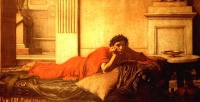Emotion
From The Art and Popular Culture Encyclopedia

Emotion, in its most general definition, is an intense mental state that arises automatically in the nervous system rather than through conscious effort, and evokes either a positive or negative psychological response. An emotion is similar to a feeling.
Classification
There are basic and complex categories, where some basic emotions can be modified in some way to form complex emotions (for example, Paul Ekman). In one model, the complex emotions could arise from cultural conditioning or association combined with the basic emotions. Alternatively, analogous to the way primary colors combine, primary emotions could blend to form the full spectrum of human emotional experience. For example interpersonal anger and disgust could blend to form contempt.
Further to this, relationships exist between basic emotions, such as having positive or negative influences, with direct opposites existing. The contrasting and categorization of emotions describes these relationships. Robert Plutchik proposed a three-dimensional "circumplex model" which describes the relations among emotions. This model is similar to a color wheel. The vertical dimension represents intensity, and the circle represents degrees of similarity among the emotions. He posited eight primary emotion dimensions arranged as four pairs of opposites. Some have also argued for the existence of meta-emotions which are emotions about emotions.
A distinction is then made between emotion episodes and emotional dispositions. Dispositions are also comparable to character traits, where someone may be said to be generally disposed to experience certain emotions, though about different objects. For example an irritable person is generally disposed to feel irritation more easily or quickly than others do. Finally, some theorists (for example, Klaus Scherer, 2005) place emotions within a more general category of "affective states" where affective states can also include emotion-related phenomena such as pleasure and pain, motivational states (for example, hunger or curiosity), moods, dispositions and traits.
The neural correlates of hate have been investigated with an fMRI procedure. In this experiment, people had their brains scanned while viewing pictures of people they hated. The results showed increased activity in the medial frontal gyrus, right putamen, bilaterally in the premotor cortex, in the frontal pole, and bilaterally in the medial insula of the human brain. The researchers concluded that there is a distinct pattern of brain activity that occurs when people are experiencing hatred (Zeki and Romaya, 2008).
Notable theorists
In the late 19th century, the most influential theorists were William James (1842–1910) and Carl Lange (1834–1900). James was an American psychologist and philosopher who wrote about educational psychology, psychology of religious experience/mysticism, and the philosophy of pragmatism. Lange was a Danish physician and psychologist. Working independently, they developed the James–Lange theory, a hypothesis on the origin and nature of emotions. The theory states that within human beings, as a response to experiences in the world, the autonomic nervous system creates physiological events such as muscular tension, a rise in heart rate, perspiration, and dryness of the mouth. Emotions, then, are feelings which come about as a result of these physiological changes, rather than being their cause.
Some of the most influential theorists on emotion from the 20th century have died in the last decade. They include Magda B. Arnold (1903–2002), an American psychologist who developed the appraisal theory of emotions; Richard Lazarus (1922–2002), an American psychologist who specialized in emotion and stress, especially in relation to cognition; Herbert Simon (1916–2001), who included emotions into decision making and artificial intelligence; Robert Plutchik (1928–2006), an American psychologist who developed a psychoevolutionary theory of emotion; Robert Zajonc (1923–2008) a Polish–American social psychologist who specialized in social and cognitive processes such as social facilitation. In addition, an American philosopher, Robert C. Solomon (1942–2007), contributed to the theories on the philosophy of emotions with books such as What Is An Emotion?: Classic and Contemporary Readings (Oxford, 2003).
Influential theorists who are still active include psychologists, neurologists, and philosophers including:
- Lisa Feldman Barrett – Social philosopher and psychologist specializing in affective science and human emotion.
- John Cacioppo – from the University of Chicago, founding father with Gary Berntson of social neuroscience.
- António Damásio (born 1944) – Portuguese behavioral neurologist and neuroscientist who works in the US
- Richard Davidson (born 1951) – American psychologist and neuroscientist; pioneer in affective neuroscience.
- Paul Ekman (born 1934) – Psychologist specializing in study of emotions and their relation to facial expressions
- Barbara Fredrickson – Social psychologist who specializes in emotions and positive psychology.
- Nico Frijda (born 1927) – Dutch psychologist who specializes in human emotions, especially facial expressions
- Peter Goldie – British philosopher who specializes in ethics, aesthetics, emotion, mood and character
- Arlie Russell Hochschild (born 1940) – American sociologist whose central contribution was in forging a link between the subcutaneous flow of emotion in social life and the larger trends set loose by modern capitalism within organizations.
- Joseph E. LeDoux (born 1949) – American neuroscientist who studies the biological underpinnings of memory and emotion, especially the mechanisms of fear
- George Mandler (born 1924) - American psychologist who wrote influential books on cognition and emotion
- Jaak Panksepp (born 1943) – Estonian-born American psychologist, psychobiologist and neuroscientist; pioneer in affective neuroscience.
- Jesse Prinz – American philosopher who specializes in emotion, moral psychology, aesthetics and consciousness
- Klaus Scherer (born 1943) – Swiss psychologist and director of the Swiss Center for Affective Sciences in Geneva; he specializes in the psychology of emotion
- Ronald de Sousa (born 1940) – English–Canadian philosopher who specializes in the philosophy of emotions, philosophy of mind and philosophy of biology.
See also
- Affect measures
- Affective neuroscience
- Affective science
- Emotion classification
- Emotion in animals
- Emotions and culture
- Emotion and memory
- Emotional expression
- Feeling
- List of emotions
- Sex and emotion
- Sociology of emotions
- Social neuroscience

.jpg)


